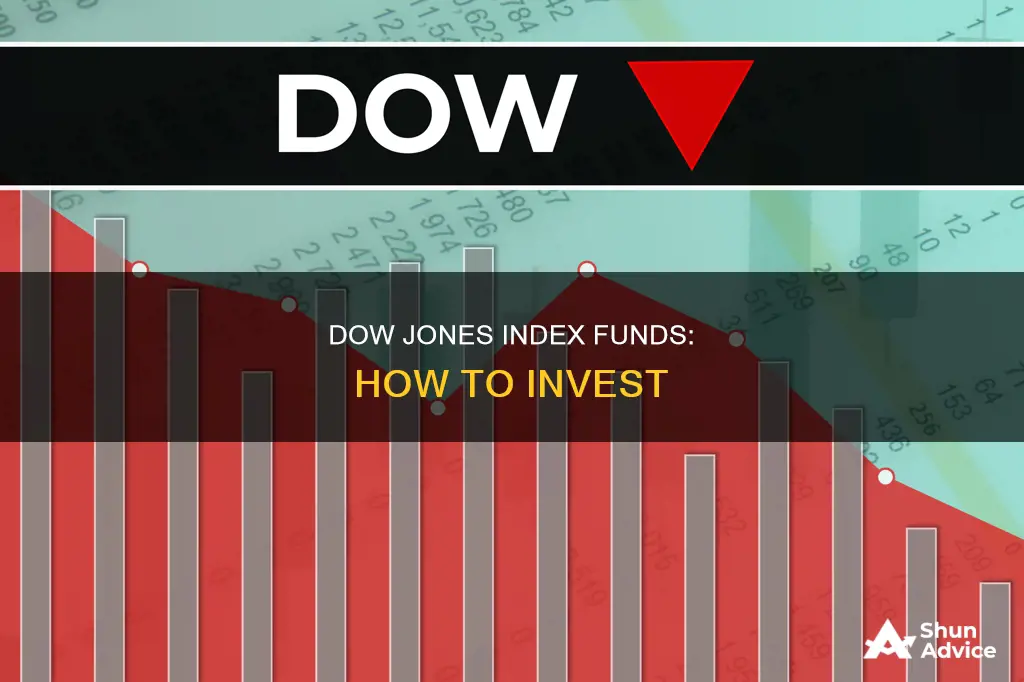
The Dow Jones Industrial Average (DJIA) is a stock market index that tracks the performance of 30 large, publicly-owned US companies. While you can't invest directly in the DJIA, you can gain exposure to the index through exchange-traded funds (ETFs) or mutual funds. The SPDR Dow Jones Industrial Average ETF Trust (DIA) is the only ETF that tracks the Dow. For investors who want to avoid the higher fees associated with mutual funds, ETFs have become a more popular option in recent years.
| Characteristics | Values |
|---|---|
| Name | SPDR Dow Jones Industrial Average ETF Trust |
| Abbreviation | DIA |
| Performance Over One-Year | 3.1% |
| Expense Ratio | 0.16% |
| Annual Dividend Yield | 1.56% |
| Three-Month Average Daily Volume | 4,083,728 |
| Assets Under Management | $31.3 billion |
| Inception Date | Jan. 14, 1998 |
| Issuer | State Street |
| Top Holdings | UnitedHealth Group Inc., Goldman Sachs Group Inc., Home Depot Inc. |
What You'll Learn

Exchange-traded funds (ETFs)
ETFs have several advantages over other investment options. They offer low expense ratios and fewer broker commissions than buying the stocks individually. They also provide access to many stocks across various industries and are ideal for young investors. Additionally, ETFs exist that focus on targeted industries, and they can be safe investments if used correctly.
When investing in ETFs, it is important to consider the expense ratio, diversification benefits, and the specific industry or sector being tracked. One popular ETF is the SPDR Dow Jones Industrial Average ETF Trust (DIA), which is the only non-leveraged, non-inverse, U.S.-traded ETF that tracks the Dow Jones Industrial Average. It has an expense ratio of 0.16% and a one-year performance of 3.1% as of December 1, 2022.
ETFs are traded through online brokers, traditional broker-dealers, or robo-advisors, and most investing platforms offer commission-free trading. After creating and funding a brokerage account, investors can search for ETFs using screening tools that consider criteria such as trading volume, expense ratio, past performance, holdings, and commission costs.
Protect Your 401k: Invest in Mutual Funds for a Secure Future
You may want to see also

Mutual funds
The Dow Jones Industrial Average (DJIA) is a stock market index that measures the performance of 30 large, publicly-owned US companies listed on the New York Stock Exchange (NYSE) and the NASDAQ. While it is not possible to invest directly in the DJIA, it is possible to invest in it indirectly through exchange-traded funds (ETFs) or mutual funds.
A mutual fund is a basket of hundreds of stocks, securities, and other assets within a single fund. Instead of purchasing a single stock, funds give you exposure to all the different shares it contains, providing instant diversification for your portfolio.
There are a handful of Dow Jones mutual funds to choose from, but the following criteria can help guide your selection:
- Minimum investment: Index funds will have varying minimum investments, so be sure to check that the minimum amount aligns with how much you have to invest.
- Expense ratio: Since index funds are passively managed, the expense ratio (the ongoing cost of holding the investment) tends to be low. Look for a fund with the lowest expense ratio.
- Dividend yield: If your index fund comes with dividends, be sure to compare the dividend yield (the amount investors are paid in dividends) of different funds you’re considering. Some may be higher than others, and capitalising on dividends is a great way to boost returns.
- SPDR Dow Jones Industrial Average ETF Trust (DIA): This is the only true DJIA fund. It is the top (and only) exchange-traded fund tracking the Dow. It is up 3% in the last year while the S&P 500 Index is down 8% as of Dec 1, 2022. DIA's top holdings are UnitedHealth Group Inc., Goldman Sachs Group Inc., and Home Depot Inc.
- Rydex Dow Jones Industrial Average® Fund: This fund seeks to provide investment results that match the performance of the Dow Jones Industrial Average® on a daily basis. It has returned 1.53% over the past year, 7.91% over the past three years, and 5.99% over the past five years. However, its fees are above average compared to funds in the same category, with an expense ratio of 1.56%.
- IShares Dow Jones US Index Fund: This fund maintains at least 90% of its holdings in the same stocks that are in the Dow Jones Large Cap index. While it doesn't perfectly track the DJIA, 19 of the 30 largest holdings in the iShares fund are parts of the DJIA.
- Schwab U.S. Large-Cap ETF: Similar to the iShares fund, this fund holds at least 90% of its holdings in the same stocks that are in the Dow Jones Large Cap index. 19 of the 30 largest holdings in the Schwab fund are parts of the DJIA.
Dividend Funds: A Smart Investment Strategy for Long-Term Gains
You may want to see also

Individual stocks
While it is possible to invest in the Dow Jones Industrial Average (DJIA) through exchange-traded funds (ETFs) or mutual funds, investors can also choose to hand-select individual stocks of companies from the Dow they want to invest in. However, it is important to note that investing in a single company comes with increased risk and volatility and requires thoughtful research and stock performance analysis.
The DJIA is a stock market index that measures the performance of 30 large, publicly-owned companies listed on the New York Stock Exchange (NYSE) and the NASDAQ. It is one of the oldest and most widely used indices, offering a snapshot of the overall health of the U.S. stock market. The index includes companies across various sectors, such as energy, healthcare, financials, information technology, and more.
- UnitedHealth Group Incorporated
- Goldman Sachs Group Inc.
- Microsoft Corporation
- McDonald's Corporation
- American Express Company
- Honeywell International Inc.
- Travelers Companies Inc.
- JPMorgan Chase & Co.
- International Business Machines Corporation
- Procter & Gamble Company
- Verizon Communications Inc.
When considering investing in individual stocks from the DJIA, it is essential to carefully evaluate each company's financial health, business model, growth prospects, and risk factors. Diversification is also crucial to consider, as the DJIA only includes 30 companies, which may not provide a comprehensive representation of the broader stock market or economy.
Pension Funds: The Benefits of Investing in TIPS
You may want to see also

Options/futures contracts
Futures contracts with values based on the Dow Jones Industrial Average stock index allow traders to make leveraged bets concerning the future of the index. With regular futures trading, the leverage cuts both ways, so picking the wrong direction with a Dow futures trade can be costly. Options on futures allow traders to set up trades with different risk profiles, changing the costs of a trade and putting a limit on the downside risk.
To start trading Dow Jones futures options, you will need to open an account with a registered commodity futures brokerage firm. Futures brokers and their representatives are required to be registered with the Commodity Futures Trading Commission (CFTC) and will also be members of the National Futures Association (NFA).
After opening an account, you will need to download and install one of the trading platforms offered by the futures broker. Discuss the choices with a broker representative based on the type of trading you want to do.
Next, study the trading platform's user manual or call the broker's trading support team to learn how to access the pricing of the Dow Jones futures and the options trading against those futures. Each type of futures contract has its own account value and pricing. For example, there are Dow futures contracts valued at five and ten times the value of the stock index. The options prices for each contract type will be priced to match the specific futures contract.
Before you start live trading, practice buying Dow futures options using the simulated trading account provided by your broker. All futures brokers include a simulated account log-in when you get a real money account. The simulated account can be used to familiarize yourself with the trading platform and to try out trading strategies. With options, call options are generally purchased to profit from a rising futures price, while put options gain value if the futures price declines.
When you are comfortable with the trading system and your results using the simulated account, you can start live trading. Your live account will use the same software with a different login and password. Make sure you always know which account you are currently logged into.
Call options give you the right to purchase the underlying futures contract at a specific exercise price, called the strike price. Put options give you the right to sell the underlying futures at the strike price. A purchased Dow futures option trade turns profitable when the futures price moves past the option strike price by more than the cost of the option.
For example, consider a put and a call option on the Dow, each with a strike price of 12,000 and a cost of 200. The call option will be profitable if the Dow Jones index and futures price climbs above 12,200. The put option is profitable if the Dow drops below 11,800. The maximum loss when buying put or call options is the amount of money you paid for the contracts.
Futures option contracts are rarely exercised because any remaining premium in the option would be lost. The way to get out of a purchased options trade is to make an offsetting sell trade.
Invest Wisely: Strategies for Fidelity Funds
You may want to see also

Fractional shares
There are a few downsides to fractional shares. If you want to transfer your shares to a different broker, fractional shares may need to be sold before the transfer can take place. Additionally, if you are investing in dividend stocks as fractional shares, the amount you receive in dividends will be proportional to how much of the share you own.
- Charles Schwab: Allows investors to buy a fractional share of any stock in the Standard & Poor's 500 Index for as little as $5.
- Fidelity Investments: Allows investors to start with just $1 and buy shares of more than 7,000 stocks and ETFs listed on U.S. exchanges.
- Interactive Brokers: Offers fractional shares on its Pro and Lite platforms.
- Robinhood: Allows investors to buy as little as one-millionth of a share.
- SoFi Active Investing: Allows investors to buy fractional shares directly for a minimum of $5 and reinvest dividends into fractional shares.
The SPDR Dow Jones Industrial Average ETF Trust (DIA) is an exchange-traded fund that tracks the Dow Jones Industrial Average, which is comprised of about 30 large-cap stocks. DIA is the only non-leveraged, non-inverse, U.S.-traded ETF that tracks the Dow. As of December 1, 2022, DIA's top holdings included UnitedHealth Group Inc., Goldman Sachs Group Inc., and Home Depot Inc.
While there is limited information available on buying fractional shares of the Dow Jones Industrial Average, some brokers, such as Fidelity Investments, do allow investors to buy fractional shares of a wide range of stocks and ETFs. Therefore, it is likely that investors can buy fractional shares of the SPDR Dow Jones Industrial Average ETF Trust (DIA).
Setting Up an Investment Fund: A Child's Future Security
You may want to see also
Frequently asked questions
The Dow Jones Industrial Average (DJIA) is a stock market index made up of 30 large, publicly-owned "blue chip" companies in the United States. It is considered a key indicator of the overall health of the U.S. stock market.
While you can't invest directly in the Dow Jones, you can invest through exchange-traded funds (ETFs) that track the index, mutual funds that invest in companies included in the index, or by purchasing shares in the individual companies that make up the index.
The SPDR Dow Jones Industrial Average ETF (DIA) is the top (and only) exchange-traded fund that tracks the Dow. Other ETFs that track the Dow include the Nationwide Dow Jones Risk-Managed Income ETF (NDJI) and the ProShares Ultra Dow30 (DDM).
Some mutual funds that track the Dow Jones include the iShares Dow Jones US Index Fund and the Schwab US Large-Cap ETF. While these funds don't perfectly track the Dow Jones Industrial Average, they come close, with 19 of the 30 largest holdings in both funds being parts of the DJIA.
Investing in the Dow Jones can provide consistent long-term returns, instant diversification, and exposure to blue-chip stocks, or reliable long-term investments.







